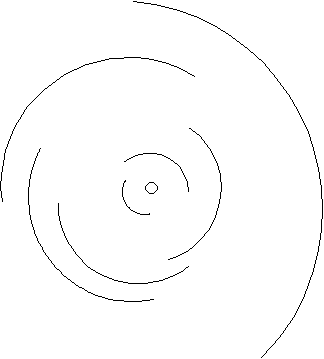
Due October 12, 1995
Reading Assignment: read Sidereus Nuncius. Many of the questions below are related to material in that book.
1. If you leave a camera flat on its back at the North Pole for a several hour time exposure, the motion of the stars would give a picture looking something like this:

(Individual star positions here are not accurate, the main point is the stars' movement during the exposure can be seen. The little circle in the middle should be taken to be a single point - it's hard to draw single points. The other arcs are centered on that.)
(a) Roughly how long was the exposure? Explain your answer.
(b) Sketch the kind of similar(?) picture you would expect to see if you did a time exposure at night for a camera flat on its back on the equator.
2. Galileo's claim that there were mountains on the moon met with the response that if there were, the moon wouldn't look so perfectly round, it would have a jagged edge. What was his response? Was he right?
3. Galileo observed that through the telescope, the planets were disk like, but the stars were still points. Why did that observation weaken the case against the Copernican theory?
4. (a) Why did the observation of moons around Jupiter strengthen the Copernican theory?
(b) Why are Jupiter's moons called the Medicean satellites?
(c) How did the observation of Jupiter's moons lead eventually to much more accurate geographic maps of countries here on earth?
5. (a) The moon is two days past half full on the day this assignment is handed out (October 3). What direction in the sky will the moon be at sunset?
(b) Sketch the phase of the earth as seen from the moon on the same day.
(c) The moon will be full on October 8. What direction in the sky will it be in at sunset?
(d) The moon always shows the same face to the earth (although it wobbles a bit). From that fact, what can you say about the path the earth takes across the moon's sky as seen by an astronaut living on a moonbase?
6. Sketch the orbit of Venus in both the Ptolemaic and the Copernican schemes. Galileo observed that Venus has phases, just like the moon. (These phases cannot be seen without a telescope.)
(a) Sketch the possible phases of Venus when it appears fairly close to the sun in both schemes. Be careful to show how the apparent size of Venus might change for different situations. How did Galileo's observations of Venus strengthen the case for the Copernican scheme?
(b) Assume the furthest angular distance Venus ever gets from the sun is 45 degrees. (This is fairly close to the truth.) How far is Venus from the sun as a fraction of how far the earth is from the sun?